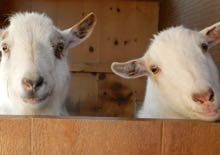I believe in having well-trained animals – it’s safer and less frustrating for everyone, animals and people alike. Good training doesn’t have anything to do with being the “alpha” or subservience or taking advantage of another being. Good training is a matter of observation and communication. It’s thinking through what behavior you want and taking positive steps to get there. It’s fun.
Here’s Lily Dog, putting Scooter’s toys away.
I train Lily using a technique called “clicker training.” I let her know she’s done what I want with a “click” sound (you’ll hear it on the video) and then she’s rewarded with bits of cheese. But, it’s not the cheese that’s making her happy – it’s having a task to do and doing it well. Don’t we all know that feeling!

How fun!! Lily’s a smart girl!
Lily not only has good looks she also has some smarts.I think I ‘ll try it with my little black lab Bella. Wish me luck !
The trick to teaching this is to break it down into small bits. Lily already had a “get it” cue (she’d pick up and bring me what I pointed at.) I put the basket right at my feet, so it sometimes dropped in. Slowly I moved away from the basket. Slowly I added toys that were harder to get into the basket. Labs LOVE to pick up things and then drop them. I’m sure Bella will love this trick!
Blimey your house is clean! Does Lily push the vacuum round too? Does Scooter do any jobs, clicker-trained? Or do some dogs just not have the right temperament for it – possibly he feels he can just sit back and let Lily do all the work!
Notice that the carpet is the color of Lily hair! Lily is a dog that needs lots of interaction and things to do. Scooter is happy napping, and playing with a ball once in awhile. A very low demand dog. His only job is to be cute. He does it very well! He’s happy as is and he’s well behaved, so we leave him be. Also, for awhile I thought I’d train Scooter to do a trick or two. I’d have Lily in a downstay, watching. Scooter is not quite as bright as Lily, and Lily would get so frustrated watching him learn! She’d jump up, shove him away and do the trick. Not for the treat, but more a “you silly little dog, it’s easy, do this!” She learned several tricks, just watching. Scooter never learned them completely. It was very funny.
You can just tell by watching Lilly that she is one smart dog. And Scooter, well, just too darn cute.
Yes, cute. See my comment to Wendy. Cute, but you can see those gears in this brain working…slowly.
What a GOOD GIRL!
That’s great! I doubted you when you said that it wasn’t the cheese that was making Lily happy, it was the job. Well, then I watched the video, and it’s obvious by her body language that she gets great joy from pleasing you! I have two Mini Schnauzers and one of them, Cooper is very much motivated to please, while my other, Gem, is totally food motivated. It makes it much more difficult to train Gem because he can barely control himself and listen to my voice because he gets very worked up about the food. Cooper on the other hand has great focus and it’s, like you said, because he enjoys doing the job well and pleasing me. I think I will work on that trick in my house. Sometimes it’s easier to work with Cooper without Gem around because Gem can’t sit still while I treat Cooper. I haven’t tried clicker training yet but have always been interested. Is the point to clicker training to have an audio cue for an achieved goal without having to food reward each time? From what I’ve read though, in the beginning you treat with every click and then wean slightly so a treat is intermittent. Is this correct?
Thanks for sharing Terry! Very much an interest of mine.
Cheese DOES make Lily happy, and I couldn’t have trained her without giving her tangible, immediate rewards. But, once she’s mastered a trick, the trick itself becomes self-rewarding. I do believe that many animals enjoy the feeling of being good at something – of achievement. Also, the entire experience of training becomes rewarding. As far as dogs that focus on the food and not the handler – that problem is solved with clicker training. The food is not in your hand. It doesn’t even have to be on your person. The dog works for the click- and then gets the treat. It focuses the dog on problem-solving the task which causes the trainer to click, not on the food. The trainer clicks at the moment the dog does the wanted behavior. The dog can be at quite a distance away, do the behavior, hear the click and come running for the reward. Read Karen Pryor’s “Don’t Shoot the Dog” and “Reaching the Animal Mind” and you’ll get why it all works so beautifully.
Oh I love the bow at the end. And NO talking back.
I just LOVE dogs!!!!!